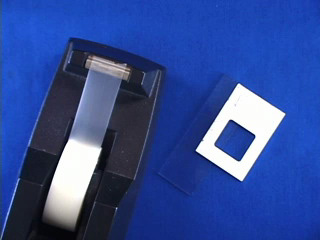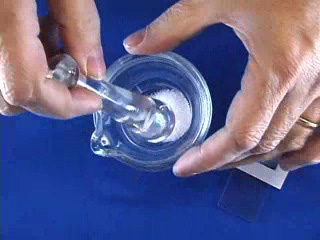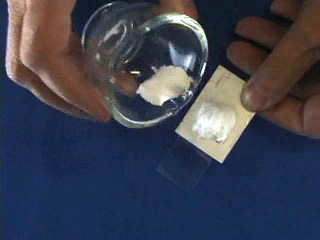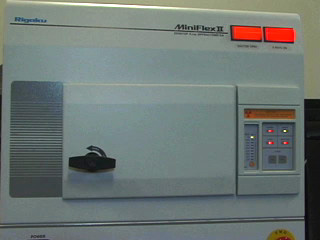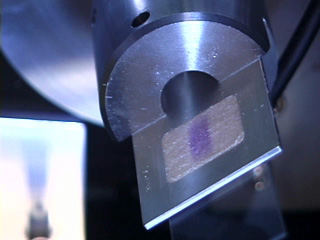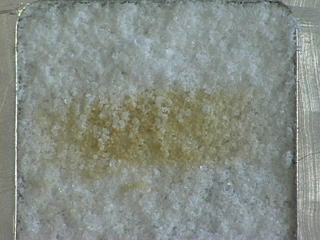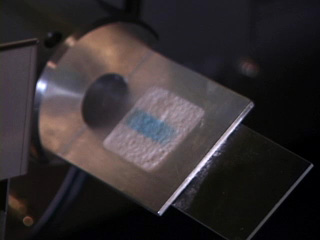
Preparation of F-centers by Powder X-ray Diffraction
This experiment was developed by Paul Hansen and George Lisensky.
Shining x-rays on alkali halides excites electrons into halide vacancies (an F-center). The observed color depends on the size of the vacancy which depends on the size of the unit cell. Read more information about F-centers.
| Procedure | Wear eye protection |
Prepare a microscope slide with an aluminum holder. Take a piece of tape and wrap it around the slide so that the sticky side is facing out. Place the aluminum holder on top of the slide with the tape centered in the hole. The end of the aluminum must match the end of the slide. Since the instrument is a powder x-ray diffractometer your sample should be a powder. Grind the sample using a rotary motion with a mortar and pestle. The finer the powder the better the data. Pour the powder on to the holder. Use another microscope slide to wipe off the excess. Best results are obtained if the sample is level and as deep as the holder. When you turn the latch to open the door the yellow light labeled “shutter open” will turn off. This is because turning the latch closes the shutter between the x-ray tube and the sample. With the shutter closed x-rays will not be present.
Make sure the plastic tray is under the sample. This container is meant to catch any powder which could otherwise fall to the x-ray source and damage the machine. Hold both the slide and the aluminum holder. Insert the pair together into the clip holder. Run a powder diffraction scan of an alkali halide. (The sample must be tilted to get a direct beam on the sample and create F-centers.) At the end of the scan, open the door to release the shutter and block the x-rays. Immediately observe the color of the irradiated area. Different alkali halides have different color F-centers. (F is an abbreviation for Farbe, the German word for color.) How long does it take, as illustrated by the loss of color, for the electron in the F-center to return to its origin? Do different materials take the same time?
1. Predict the relative sizes of the KBr, KCl, and NaCl unit cells.
2. The tallest peak is the 200 reflection. What is your measured size
of the unit cell?
3. What are the F-center colors for each of these?
4. Does the spectral order of the colors match the unit cell sizes?
- KCl
- NaCl
- KBr
- Powder X-ray Diffractometer (Rigaku Miniflex-II shown here.)
Developed in collaboration with the
University of Wisconsin Materials Research Science and Engineering Center
Interdisciplinary Education Group | MRSEC on Nanostructured Interfaces
This page created by George Lisensky, Beloit College. Last modified June 16, 2013 .
University of Wisconsin Materials Research Science and Engineering Center
Interdisciplinary Education Group | MRSEC on Nanostructured Interfaces
This page created by George Lisensky, Beloit College. Last modified June 16, 2013 .
